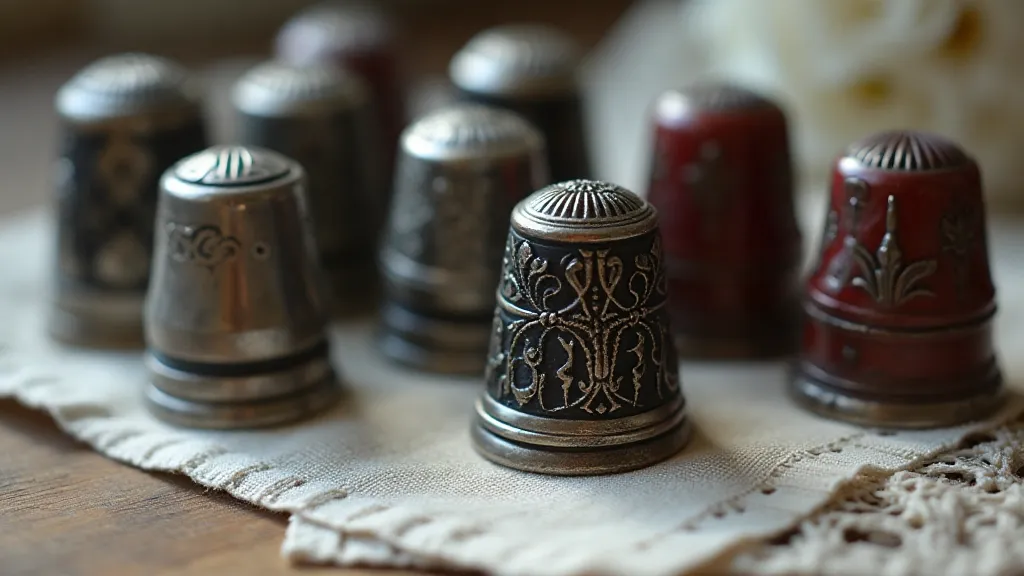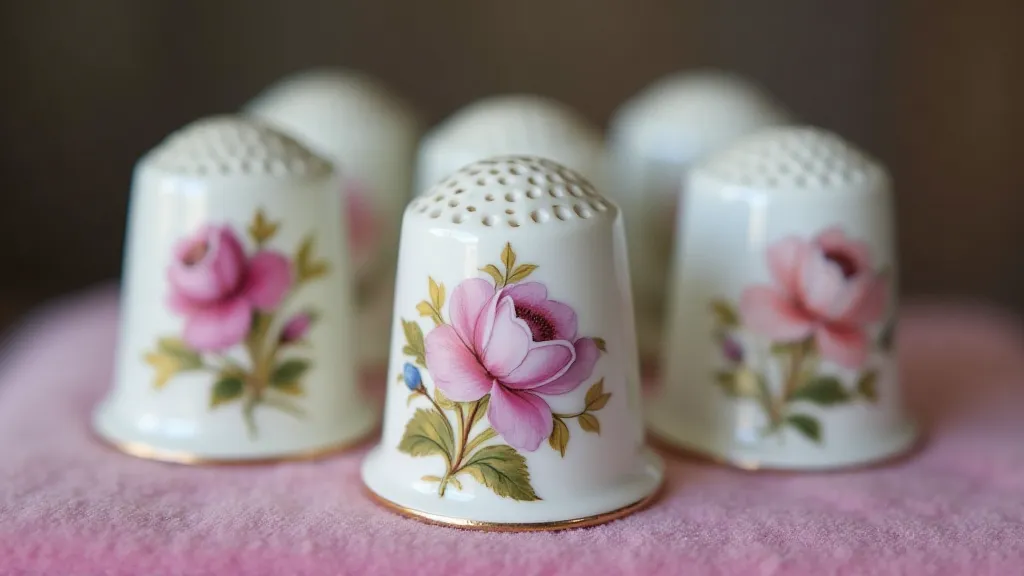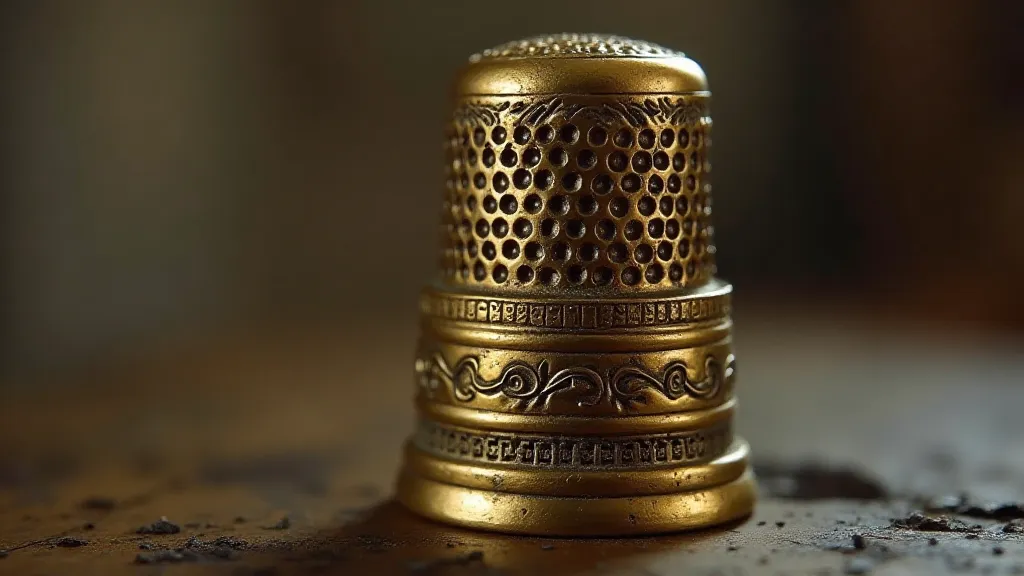Chromatic Whispers: The Language of Color in Antique Thimble Decoration
There's a quiet intimacy in holding an antique thimble. More than a simple sewing accessory, these tiny vessels are fragments of lives lived, whispers of generations past. I remember, as a child, discovering a box of my great-grandmother's thimbles. They weren’t pristine, perfectly cataloged treasures. They were worn, marked by years of diligent use, and yet, each one held a story – a faint, almost palpable echo of the hands that guided them. It was the colors, more than anything, that captivated me. They weren’t just decorative; they spoke a language I instinctively felt but couldn’t fully understand.
Today, as a collector and admirer of these miniature heirlooms, I've begun to unravel that language. It's a language woven into the pigments, the glazes, and the enamel, a visual poetry reflecting the cultural beliefs, historical events, and personal sentiments of the time they were created. Understanding the symbolic meaning behind these colors offers a deeper appreciation for the artistry and the lives intertwined with these humble tools. For some, the pursuit of these miniature treasures evolves into a deep obsession, a way to connect with the past and preserve a piece of history. It's a world where the smallest detail holds immense value, as explored in detail in The Collector's Shadow: Obsession, Memory, and the Pursuit of Miniature Perfection.

Black: Mourning and Remembrance
Perhaps the most immediately striking color is black. In the Victorian era, a period responsible for a significant portion of surviving antique thimbles, black held profound significance. The era’s mourning rituals were extensive and deeply ingrained in society, extending to every facet of life, including personal possessions. The loss of loved ones was a constant presence, and displays of grief were commonplace. Black enamel thimbles, therefore, were often created to commemorate the deceased, serving as poignant reminders of loss and a tangible expression of mourning. Their presence wasn’t about celebrating life; it was a testament to respect for those who had passed.
These weren't always solely about grief. Sometimes, the black enamel was combined with gold accents, symbolizing hope and the promise of eternal life. The contrast served as a reminder that even in the darkest times, light persists. Consider, too, that black was also a color of authority and solemnity. A black thimble might have been worn by a seamstress working for a wealthy or important family, signifying her role and the gravity of her task. These often carried echoes of the lives of those who crafted them, a history etched in silver and enamel, revealing the silent narratives of forgotten hands, as revealed in Echoes in Silver: The Silent Narratives of Forgotten Hands.
White and Silver: Purity, Innocence, and Prosperity
In stark contrast to black, white and silver evoked sentiments of purity, innocence, and even prosperity. White, representing new beginnings and cleanliness, was often paired with delicate floral motifs or depictions of cherubs. Silver, being a precious metal, also symbolized wealth and good fortune. Silver thimbles, especially those elaborately chased or engraved, were often gifts given to young women learning to sew, representing blessings for a happy and prosperous future. My grandmother, a masterful quilter, had a silver thimble inherited from her own mother – a tangible symbol of the skills and traditions passed down through generations. It always felt like more than just a thimble; it was a connection to a lineage of creativity and resilience. These objects often began as parlor treasures, gradually making their way into pockets and collections, reflecting changing lifestyles and the evolving appreciation for these miniature relics.
Red: Passion, Courage, and Vitality
Red, a vibrant and energetic color, held a spectrum of meanings. It could symbolize passion, courage, and vitality, but also warning and danger. In the context of antique thimbles, red was often associated with love, warmth, and good luck. A red enamel detail on a thimble might represent a bride's happiness or a mother’s devotion to her family. There’s a delightful set of German thimbles from the late 19th century depicting traditional folk characters, many of whom are adorned in vibrant red costumes – a joyous celebration of cultural heritage.

Blue: Loyalty, Faith, and Tranquility
Blue, representing loyalty, faith, and tranquility, offered a sense of calm and stability. Different shades of blue carried distinct connotations – deep blues symbolized constancy and reliability, while lighter blues evoked feelings of peace and serenity. It’s fascinating to observe how blue was often employed in thimbles intended for children, conveying a sense of safety and comfort. The delicate use of cobalt blue in antique Meissen thimbles, known for their exquisite craftsmanship, is particularly mesmerizing, a true testament to the mastery of enamel artistry. The journey of these collections, from elaborate parlor displays to more intimate pocket keepsakes, offers a fascinating perspective on changing societal norms, illustrating the portability of treasures and the shifting values surrounding them.
Green: Hope, Fertility, and Renewal
Green, symbolizing hope, fertility, and renewal, resonated with the cyclical nature of life and the promise of new beginnings. It was often associated with the natural world, conveying a sense of harmony and balance. A green thimble might have been given to someone embarking on a new venture, representing growth and prosperity. Imagine a farmer's wife, mending clothes by the fire, using a simple green thimble as a silent symbol of hope for a bountiful harvest.
Yellow and Gold: Prosperity, Joy, and Intelligence
Yellow and gold, representing prosperity, joy, and intelligence, brought a touch of sunshine and optimism. Gold, of course, amplified the sense of wealth and luxury. While less common than other colors due to the cost of materials, gold accents on a thimble signified status and refinement. The joyful use of yellow in depicting sunflowers or other bright flowers on a thimble conveys a feeling of happiness and abundance.

Beyond the Hue: Craftsmanship and Context
Understanding the colors is just one layer of appreciating antique thimbles. The craftsmanship involved – the precision of the enamel work, the intricacy of the engraving, the quality of the metal – all contribute to their value and their story. Knowing the era of creation, the region of origin, and the social context in which the thimble was made deepens the appreciation of its significance. These tiny objects, often overlooked, are profound windows into the past, whispering chromatic secrets waiting to be deciphered. The stories these objects hold connect to the larger historical narrative, reflecting the societal hierarchies and customs of the time. The very act of collecting and preserving these remnants contributes to a deeper understanding of cultural shifts and individual lives, demonstrating how seemingly simple objects can encapsulate significant historical moments.
The sheer variety of designs and colors, combined with the intricate techniques used in their creation, speaks to a rich history of artistry and craftsmanship. The careful selection of materials, the skill required to apply the enamel, and the precision of the engraving all contribute to the overall beauty and value of these miniature heirlooms. For example, the use of different metals, like brass, silver, and gold, each holding a distinct cultural and economic significance.
Furthermore, the study of antique thimbles often intertwines with other historical disciplines, such as fashion history, textile arts, and social anthropology. Examining the types of fabrics used in conjunction with the thimbles, analyzing the design motifs, and researching the lives of the individuals who used them can provide valuable insights into the past.
The next time you hold an antique thimble, take a moment to truly observe its colors. Consider the hands that crafted it, the lives it touched, and the stories it holds. You might be surprised at the depths of history and emotion you discover within this humble sewing accessory. It’s a connection to a past that continues to resonate, one tiny, colorful stitch at a time.





